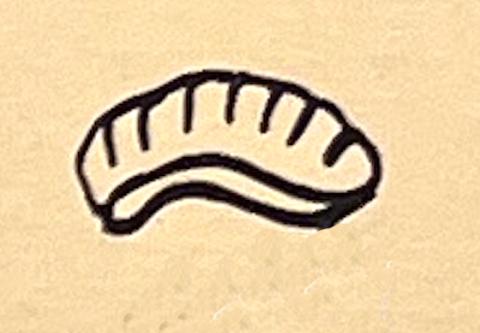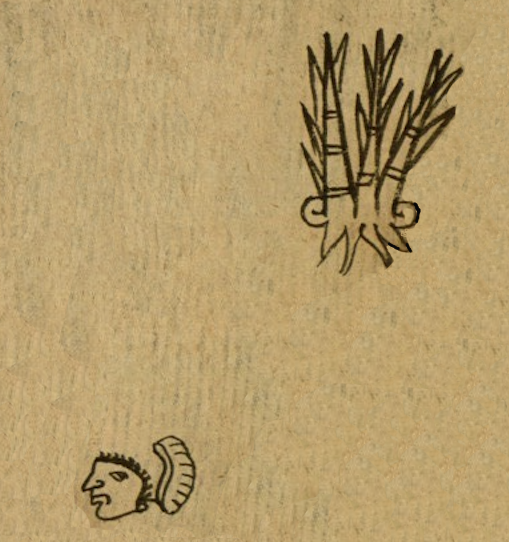nahualli (HJ276:79:pt1:24r)
This is a simplex glyph of a shamanic transformation or form-changing nahualli that in context serves as a name glyph. It consists of a black and white image placed originally behind the head of a male individual and linked to him by a short black line (see the historically contextualizing image). The visual is something like a cocoon, perhaps suggesting the transformation aspect of cocoons. It is curved with a bottom layer and segmentation lines across the top.
Robert Haskett
Nahuales were perceived as "form-changing shamans" (in the words of James Maffie, 2013, 39), sometimes taking on the attributes or abilities of animals, such as a jaguar, and becoming that creature as a "temporary incarnation of cosmic reality" (Maffie, 40, citing Raymond Fogelson). The term nahualli can refer to the shamanic power of transformation or it can refer to the being into which the shaman transforms, such as an animal, according to James Maffie (Aztec Philosophy, 2014, 38.)
This simplex glyph appears on a pictorial manuscript submitted by indigenous petitioners on or around October 7, 1549, as evidence during a land dispute between the Cuernavacan community of Xallan and the Marquesado del Valle over the alleged usurpation eleven years previously of a parcel of community land by the Marqués, who had it planted with sugar cane. The pictorial is included in the group of manuscripts known as the Códice del Marquesado del Valle. The glyph connected with the head of a male appears below an image of sugar cane on the parcel outlined on the far right of the manuscript. He is not named in any of the texts accompanying the pictorial, but may have had Nahual as his surname, since it is known to have been in use in the region during the sixteenth century. However, other male names present in the area at the time with the nahual element included Nahualatl and Nahualton. For more information, consult Códices indígenas de algunos pueblos del Marquesado, 1933 and 1883, “Códice núm. 2; Santiago Sánchez, Códices del Marquesado del Valle, 2003, 90-94; McCaa, Robert, “Matrimonio infantile cemithualtin (familias complejas) y el antiguo pueblo Nahua,” Historia Mexicana, XLVI:1 (1996), 55.
Robert Haskett
1549
Robert Haskett
personal name, sorcerer, brujo, hechicero, nombre de persona, chamán, transformación, xiuhpohualli, año, turquesa, xihuitl

nahual(li), a shamanic transformation or form-changing, a sorcerer, or a shape-shifter, https://nahuatl.wired-humanities.org/content/nahualli
el nahual
Robert Haskett
Single-page codex, Archivo General de la Nación, México, Ramo de Hospital de Jesús, leg. 276, Exp. 79, pt. 1, fol. 24r.
The Archivo General de la Nación (AGN), México, holds the original manuscript. This image is published here under a Creative Commons license, asking that you cite the AGN and this Visual Lexicon of Aztec Hieroglyphs.






